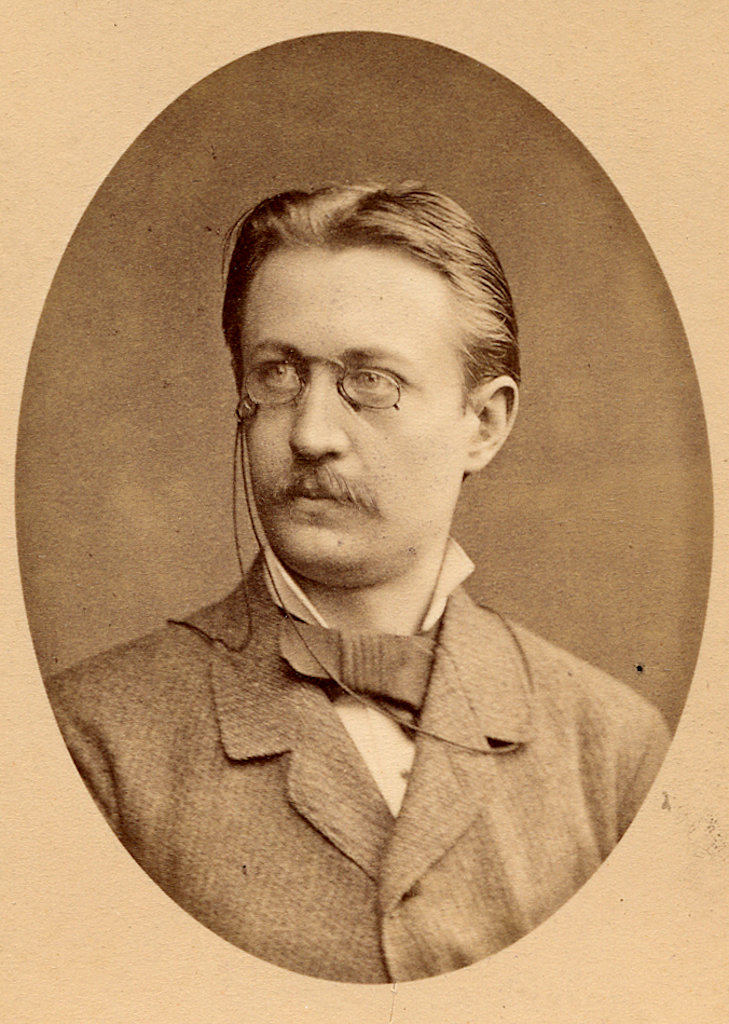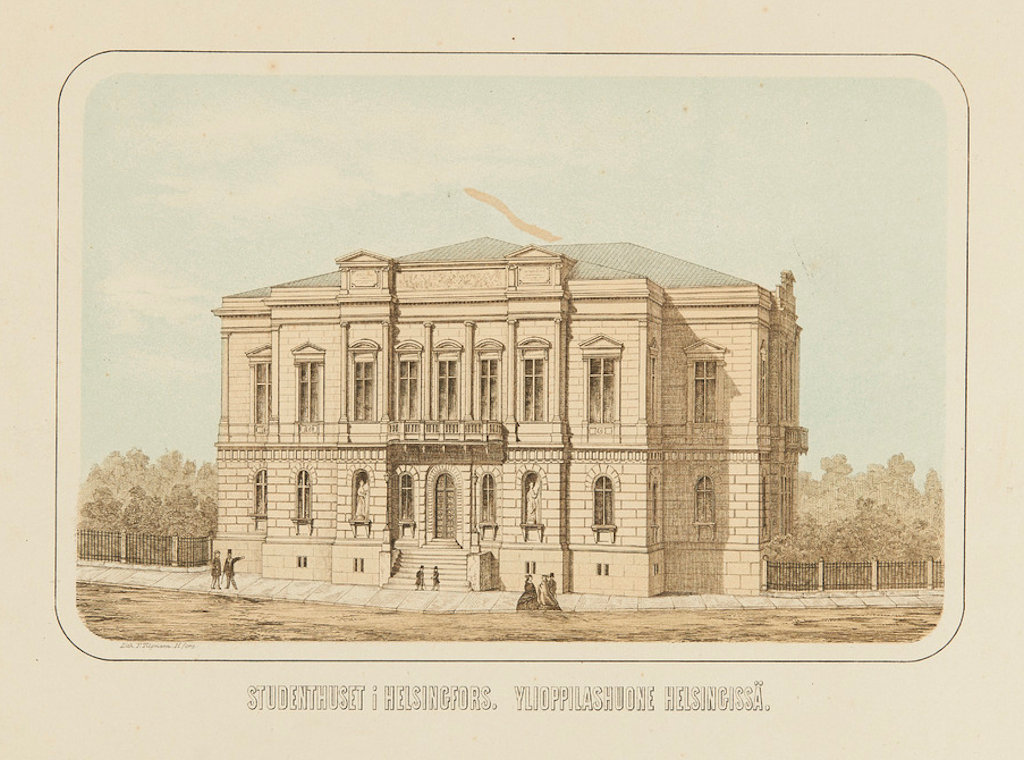A gold ring rests on a purple velvet pillow in a leather case. A golden building glows against a dark-blue enamel ring base, with a golden lyre glimmering above the building. Today, the building is known as the Old Student House, but when the ring was forged, the unique edifice had just been completed – a building for the nation’s young hopefuls!

A number of rings commemorating the construction process were made at the time. The ring included in the collections of the Helsinki University Museum belonged to Carl Gustav Borg, a university lecturer, writer and translator. Another ring, which used to belong to businessman Nikolai Kiseleff, is safe and sound in the archives of the University’s Student Union. The University Museum has no information on the fate of the other rings.
Previous owner of the ring
Who then was Carl Gustav Borg? Born in the Northern Ostrobothnia region of Finland in 1823, he completed a master’s degree in Helsinki and later conducted research on language and translated both fairy tales and legislation. He also served as extraordinary lecturer of Finnish at the Imperial Alexander University and held elected positions in the Finnish Literature Society and the Diet. In fact, the ring came to his possession through his position on the Student House’s five-member construction committee. Borg had a versatile career: for example, he administered the affairs of Elias Lönnrot, a physician, philologist and collector of traditional Finnish oral poetry, and organised his funeral.

Students as tenants
As early as the 1850s, the Student Union and faculties together rented a whole floor of a stone building, including an outbuilding, owned by city surgeon Fredrik Pihlflyckt. However, the high rent gave rise to the idea of constructing an all-new building just for students. The matter was officially discussed in 1858 at a meeting of the faculty of history and philology. The identity of the person who first proposed the construction of the building has later been the subject of debate. One of the names put forward was C. G. Borg, who was the faculty’s curator and extraordinary lecturer in Finnish at the time.
The project strikes the right chord
The construction project required funds. At the recommendation of the University Senate and the deputy chancellor, the emperor gave students permission to raise funds. Various events and plays were organised, but student singing events proved the most productive source of revenue. A triple quartet founded for the purpose toured the country, raising funds. This is the reason for the inscription Spei suae patria dedit (‘The fatherland gave to the hopeful’) above the entrance to the building.
Change of plans
Originally, a plot was acquired for the building on what is now the site of the National Archives of Finland. However, after a series of phases and difficulties, the plot in the corner of Aleksanterinkatu and Itä-Heikinkatu (now Mannerheimintie) streets was chosen instead. The plans for the building itself also underwent significant changes. It was proposed that the building have three or four storeys and that it also accommodate other parties, such as the National Museum of Finland. Eventually, the decision was made to build a two-storey building.
Construction committee and architect
When the plot had been acquired and an appropriate nest egg had been built up, it was decided in 1867 to elect a construction committee that would hire an architect, inspect the drawings, see to the instalment of the foundation piles, the levelling of the plot and the erection of the building itself, and regularly report on progress to the Student Union. The five members elected to the construction committee included C. G. Borg, who had managed the project funds since 1863. The board selected Axel Hampus Dahlström as the architect. He was also the first architect (later director general) of the National Board of Public Buildings. Dahlström drew a plan for a neo-Renaissance building with a banqueting hall at its centre. The building also included a restaurant, a library and rooms for the meetings of student associations and faculties as well as a smaller venue known as the music hall. The emperor approved the drawings in 1869, and the building was completed the following year.

Inauguration celebration
The building was inaugurated on 26 November 1870. The date was chosen to commemorate the University’s opening on the same day in 1722 after it had been closed due to the Great Northern War. The inauguration programme included a morning celebration held in Finnish and Swedish, with the construction committee attending as honorary guests. The celebration began and ended with the song Maamme (‘Our Land’), now the Finnish national anthem. After the other guests had left, the Student Union presented the members of the construction committee with gold rings. The festivities continued in the evening with a ball. At a dinner held the next day, the participants raised their glasses to the triple quartet singers, architect Dahlström and the construction committee.
Public and private
From the outset, the construction project drew the attention of the press and the public. The press reported eagerly on the fundraising campaign, the building plans and the issue of which language or languages would be used at the inauguration ceremony. The donation of the gold rings was also promptly chronicled. The Old Student House and events held there have been in the public eye in later years as well. The building has seen its fair share of history, including a visit by Alexander III of Russia, anti-Russification activism, a performance by an underground artist that led to a prison sentence, and the occupation of the building in the late 1960s. However, students have also met each other in the building for reading, singing, celebrations and other activities without making the headlines.
This article will be published on 26 November 2020, the 150th anniversary of the Old Student House. What will the future bring for the building?
Congratulations to the Old Student House, and all the best both now and in the future!

Susanna Hakkarainen, project planning officer
Sources:
Forsius, Arno: Elias Lönnrotin (1802–1884) hautajaiset 3.4.1884.
Historiallinen sanomalehtikirjasto: https://digi.kansalliskirjasto.fi/search?formats=NEWSPAPER&set_language=en
Klinge, Matti 1978: Ylioppilaskunnan historia osa 2. Kansalaismielen synty. Helsinki.
Klinge, Matti 1970: Ylioppilastalo. Helsingin Yliopiston Ylioppilaskunnan kiinteistöjen vaiheita. Jyväskylä.
